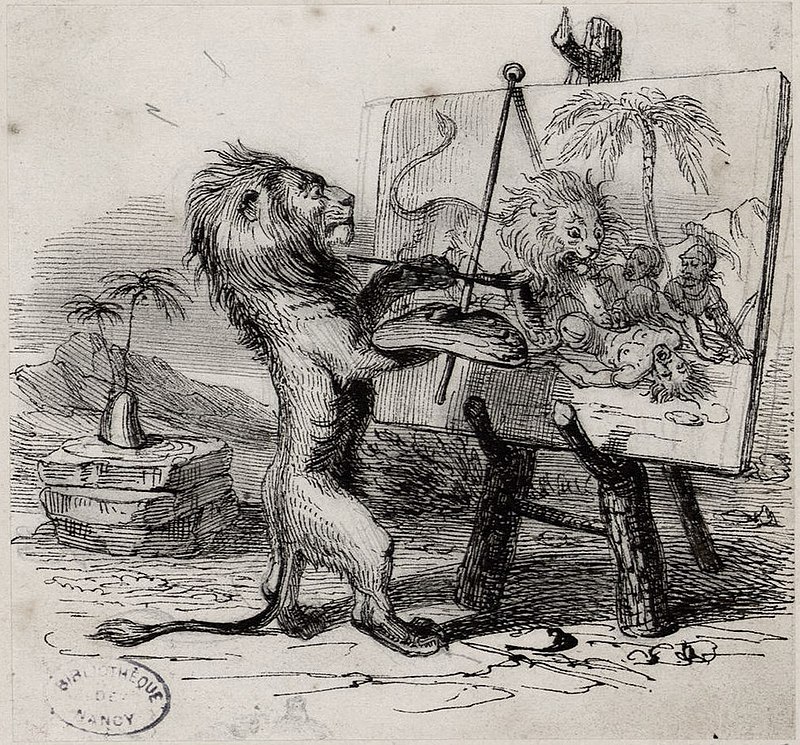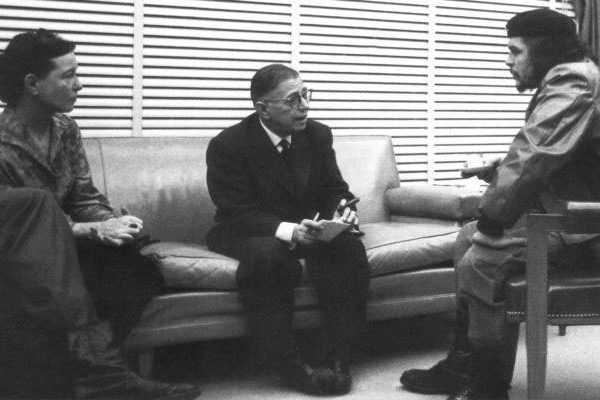Blumenberg
Sibylle Lewitscharoff, translated by Wieland Hoban
Seagull Books, $24.50 (cloth)
Lions
Hans Blumenberg, translated by Kari Driscoll
Seagull Books, $27.50 (cloth)
Humans always defeat lions in paintings because there are no lion painters. With this lesson, the griot gets up to leave, as Dani Kouyaté’s Keïta! (1995) comes to an end. The film is set in late twentieth-century Burkina Faso. The aphorism culminates a series of lessons that a folk storyteller imparts to an urban youth, all cautioning that traditional knowledge must be preserved in order to survive the country’s rapid modernization. City dwellers should learn French, but also Mandinka; they should know the oral epic Sundjata as well as they know capitalism.
But the dichotomy is not so easy to draw. The griot delivers the moral in the local language, yet most viewers would recognize it as not unique to West Africa. Versions appear in Aesop and, more significantly in this context, in the fables of La Fontaine. The lesson of cultural difference becomes one of transcultural porosity. Imparting a lesson about otherness, the anecdote refuses to reveal its own nativity; instead it attests to its own capacity to inhabit multiple cultural worlds.
Blumenberg’s subjects—from parables to aphorisms—had to contain the germ of philosophical argument, without quite articulating it.
Few scholars devote their careers to following such stories, and those who do tend to be philologists rather than philosophers. Hans Blumenberg, who died in 1996—he might just have seen Keïta!—was the rare philosopher fascinated by such traveling anecdotes. One of his monographs discusses stories of absentminded philosophers who fall down wells; another volume studies depictions of shipwrecks and people watching them.
As he chose his subjects, Blumenberg followed careful selection criteria. The stories had to be short parables, myths, or aphorisms. They had to contain the germ of philosophical argument without quite articulating it, like metaphors with vivid vehicles but ambiguous tenors. Scholars before him would have dismissed these stories as mere illustrations, but Blumenberg claimed that they are pivotal to philosophical thinking. Indeed, they constitute the hinges on which our rational edifices rest. Through the logic of metaphor, such parables buttress otherwise shaky or implausible narratives about the world and one’s own self. They assert ties between different realms of knowledge and experience that otherwise seem threateningly disconnected. Their vividness manages to convince us when rationality fails. Indeed, it might even distract us from the scandal of its failure. When such stories emerge, time and again, across different cultures, they reveal to us some shared features of our humanity.
These are idiosyncratic ideas and a counterintuitive canon. But the interest Blumenberg’s thinking has come to garner shows their continued appeal. Since the 1980s, increasing swathes of his work have appeared in English translation. They have also been the subject of diversifying commentary. The last two years brought us Lions, a translation of his reflections on the cultural life of the king of the beasts. They also saw the translation of Blumenberg, Sibylle Lewitscharoff’s novelistic homage to him.
Blumenberg was born in 1920 in Lübeck, Germany, to a Jewish mother and a Catholic father. He began his university studies in the late 1930s; the Nazis soon interrupted them. Hitler’s government compelled him to leave university and do manual labor, some of it in a concentration camp. Finally, toward the end of the war, he was forced into hiding. Blumenberg would look back on this period with great political and personal frustration. In personal terms, he regarded it as a huge loss of time. To make up for this loss, he reduced his sleep schedule in later years, filling the extra waking hours with reading and writing. His hunger for erudition, considerable before the war, became insatiate. He finally got his degree in three fields: classics, German, and philosophy.
Metaphor, for Blumenberg, constitutes the hinges on which our rational edifices rest.
These early experiences haunted Blumenberg in later years. His quest for knowledge grew relentless. His interests also turned to periods of history when traditional erudition had come under threat: the late Middle Ages in its transition to the Renaissance, then the Baroque in its transition to the Enlightenment. Historians describe this interval as the site of a “quarrel of the ancients and the moderns.” Much of Western Europe began to shed Aristotelianism in favor of new, experimental science. Traditional Catholic doctrine, grown bureaucratic and simoniac, came under threat from Protestantism. Participants in these revolutionary movements described themselves as radically breaking with the past. They saw this past, and the many tomes of its learning, as a mostly failed project that is best forgotten.
Blumenberg wondered whether these transitions were quite so radical. He expresses these doubts in his first published volume, The Legitimacy of the Modern Age (1966). Much early modern thought, retroactively praised as “secular,” was enabled by conceptual developments that began in medieval scholasticism. “This is no ‘secularization’ of man’s having been created in God’s image,” Blumenberg declares of Johannes Kepler’s and Gottfried Leibnitz’s ideas of science. “The idea of reason liberating itself from its medieval servitude,” he argues, obfuscates the huge influence the Middle Ages had on what became early modern ideas of progress and reason. Scholastic thinking itself rested on forms of knowledge that the early modern period discarded as non-rigorous, derivative, and partial. The religious myth, the aphorism, and the anecdote are not opposed to rationality. Instead, they are some of the means by which abstract thought emerges from immediate experience. Indeed, these forms’ attachment to subjectivity can never be fully transcended. Christian myths of eschatology and salvation supplied the framework within which the Enlightenment cult of reason justified itself.
Instead of being opposed to rationality, the myth and the anecdote are some of the means by which abstract thought emerges from immediate experience.
Huge and magisterial, The Legitimacy of the Modern Age garnered Blumenberg rapid fame and recognition. He generalizes these views in Work on Myth (1979) and in essays translated as Paradigms for a Metaphorology (translated in 2010). These later writings offer a broad theory of metaphoric thinking through parables, myths, and anecdotes. Such small imaginative forms are necessary connectors and catalysts of innovative thought. In reaching for them, we discover limits to rationality and recognize the associative erudition by which we supplement it. These supplements are sometimes temporary, but sometimes ineradicable. Blumenberg called ineradicable metaphoric connections “absolute metaphors.”
Blumenberg’s writing was always respected but, for a long time, not exactly popular. Some of this neglect is contextual; some it has to do with his stylistic difficulty. Twentieth-century Western thought was rent by quarrels over the value of culture and the reality of selfhood. In these quarrels, Blumenberg was often on the losing side. More interested in the stories we tell about existence than in Being as a concept, he preferred Ernst Cassirer’s and Aby Warburg’s bifurcating, cross-cultural comparisons to Martin Heidegger’s generalizations. Like Cassirer and Warburg, and unlike Heidegger, he was more drawn to the works of human hands and minds than to the non-human world. Sunk deep in history, he could come across as apolitical, with his back to the present. For postmodernists, he placed too much faith in systems of knowledge. For rationalists such as Jürgen Habermas, Blumenberg was too skeptical about abstraction and simplification; he was also too mistrustful of our capacity for enlightenment and self-awareness.
Blumenberg’s style tends toward the allusive and the gnomic. To begin one of his books can feel like entering a lecture that has already started.
On top of this contrariness, Blumenberg’s style tends toward the allusive and the gnomic. One comes to understand his arguments slowly, drawn in by a friend’s recommendation and not because a passage seduced one at a bookstore. To begin one of his books can feel like entering a lecture that has already started. (I sometimes looked, in vain, for a missing introductory chapter.) His late work collects anecdotes without much explanation or categorization; it seems to rely half on its reader’s presumed erudition and half on the anecdotes’ intrinsic charm. At their best, the books do sustain this wager. Yet the risk they thereby take is considerable.
The recently translated Lions and Blumenberg provide accessible introductions to Blumenberg’s thought. Beginning with La Fontaine’s fable about the lion painter, Lions cycles through a dozen anecdotes Blumenberg collected and commented on late in life. Most of them circle around the notion of the lion as absent or avoided. His absence or avoidance resonates with human attitudes toward natural or human others: slyness, repression, cowardice. Blumenberg traces how each anecdote travels from one author to the next. Sometimes, its emphasis changes in transition; at other times, it remains strikingly stable.
Blumenberg refuses to generalize about any “moral” these stories might collectively teach us. Indeed, he insists that part of their appeal comes from their inscrutability. We rarely know why certain bits of language appeal to us. Indeed, our attraction to them hints at the incompleteness of our self-awareness and cultural awareness. They respond to a need or relation we can articulate only obliquely, if at all.
One such lion anecdote comes from “an Arabic source.” Blumenberg finds it in Friedrich Hebbel’s quotation from the medieval encyclopedist Vincent de Beauvais:
The lion becomes feverish at the sight of a man. To cure himself of the fever, he must devour an ape. Similia similibus.
“What might have inspired Hebbel to copy down this cryptic fable?” Blumenberg asks. His answer is almost as cryptic as the fable itself:
The lion satisfies his feverish hunger for man, his only rival in the animal kingdom, by consuming the latter’s distorted image, his caricature: the ape. Hebbel does not comment on such discoveries. Indeed, he probably did not fully understand what it was about this vignette that had caught his attention. Did it hint at a solution to his problem? And if so, what was it?
An absolute metaphor: by definition, it cannot be reduced to a formula.
Instead of resolving Hebbel’s confusion, Blumenberg echoes it. He draws a parallel between Hebbel’s interest in this anecdote and the older writer’s personality, but the link remains loose and correlative; it never veers into Freudian overdetermination. Instead Blumenberg marvels at how many people seem to have preceded Hebbel in his fascination. Is his interest an instance of a more universal, existential concern? Or does it have more unique, idiosyncratic sources?
We rarely know why certain bits of language appeal to us. They respond to a need or relation we can articulate only obliquely, if at all.
Blumenberg insists that we can never fully answer such questions. What such parables do show is that the shadowy corner of experience they represent has had prior visitors. Like Hebbel and Blumenberg himself, these prior visitors were unable to bring its contents into the full light of reason. Feeling their gazes alongside one’s own, one experiences a mute intergenerational solidarity. It is almost, but not quite, a religious experience. In philosophical terms, one might describe it as a reminder of the imperfect rationality of abstractions. We do not always move into concepts through quasi-mathematical proofs. Many of them emerge from more subjective associations whose local origins and affects we cannot shed or transcend.
Sibylle Lewitscharoff’s Blumenberg approaches his thought more fantastically. An acclaimed German novelist, Lewitscharoff has authored several award-winning volumes. Many mingle realist and surrealist elements, and several feature other famous intellectual and artistic figures. Within this context, her novel about Blumenberg reads as an exploration of both his thought and Lewitscharoff’s own attraction to metaphor and magical realism.
We do not always move into concepts through quasi-mathematical proofs; we inhabit versions of confusions other people have experienced.
Blumenberg takes place in the years leading up to the philosopher’s death. As Lewitscharoff’s protagonist, Blumenberg experiences a strange visitation. In his study there appears a lion that no one else can see. The lion yawns; it sleeps; it watches him. He grows used to its presence but cannot bear to touch it. Until his mind fails him, Blumenberg plumbs its depths to determine why the lion is there. He does so in the associative ways one might have expected:
Agave’s false lion. The fable of the lion’s court. The psalmist’s lion, roaring. The lion forever vanished from the Land of Canaan. The symbolic animal of Mark the Evangelist. Mary of Egypt and her lion companion. The pious animal of Saint Jerome in his study. Who was the lion?
Meanwhile, around him, the fates of his students also veer toward death. Those of a younger generation who attend his lectures die amid illusions and quasi-mythical beliefs that are no less real to them than the lion seems to Blumenberg. Like the anecdote collectors about whom he writes, they are haunted by parables not of their own invention. One student, Hansi, collapses while delivering a raving speech on stones and lambs. “While the men dragged him towards the exit, he screamed time and again for his briefcase and his lambs. He screamed ‘It is I, I am the stone that screams!’” Another, Richard, persuades himself that he will be the savior of a teenage indigenous woman, but the woman’s family beats him to death. A third student, Gerhard, perishes like his hero Samson, in the midst of a straining academic “conquest.” Isa, whom Gerhard loves, kills herself over an obsession with Blumenberg.
Much about these plots can seem predictable, even stereotypical. But their familiarity is part of Lewitscharoff’s point. Learning does not infinitely increase our awareness and autonomy. Sometimes it only contours out our blind spots and inarticulacies. It also reminds its readers that none of us is alone in the inarticulacy and irrationality of our inner motivations. We inhabit versions of confusions other people have experienced. This knowledge cannot completely free us from illusions, but it can make us feel less alone in being beset and overcome by them. It can also, as it does for Lewitscharoff’s Blumenberg, help us accept our temporal and mental finitude with equanimity.
Not everyone will share Blumenberg’s preoccupations. But the method that leads him into the study of arcane fables is worth any reader’s attention. In today’s digital world, we often communicate through forms not unlike Blumenberg’s parables. What is a meme, after all, or a viral Facebook comment, if not such an emergent half-abstraction?
We still communicate through forms not unlike Blumenberg’s parables.
As digital data systems continue to expand, our human memories seem more anecdotal than ever. Transcultural communication reveals the subjectivity of our local thought systems with intensifying clarity. The analogies we use to move between cultures and disciplines, or between artificial intelligence and human consciousness, come to seem ever more far-fetched, like metaphors. To float in seas of such associative, anecdotal knowledge can make one feel passive. Blumenberg describes the appeal of this mode of thinking in ways that humble but also empower his reader. He helps us see its philosophical usefulness without obscuring its limits. Lions and Blumenberg lead us into his writing with gentle whimsy. Hopefully, they will inspire readers to reach for his more challenging works as well.








